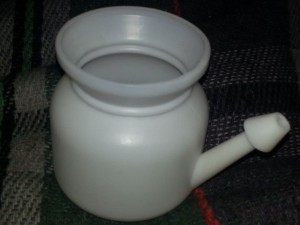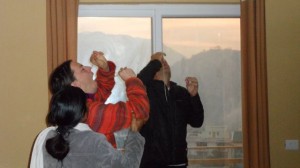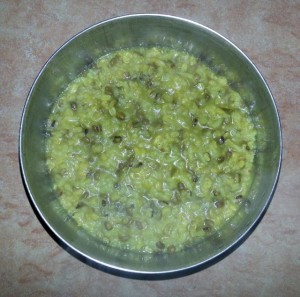Shatkarma is a detoxification process performed by yogis to purify the body and mind and includes six parts, three of which we participated in. The first part of the process we completed is called Shankhaprakshalana, or cleansing of the entire digestive tract. To do this, first thing in the morning on an empty stomach, we drank two cups of warm salt water very quickly, and then performed a series of five twisting asanas (postures) to stimulate the digestive and intestinal tracts. When this method is performed correctly, the water moves through your system very quickly. The process of drinking salt water and performing asanas is repeated until, well, your system is completely cleaned out (use your imagination). This process was not exactly easy and a couple people had a bad reaction and got sick. It’s hard to get the salt water down as it does not taste very good, and it definitely made my stomach turn since we had to drink it so quickly on an empty stomach. This process took a little over an hour and then we spent the rest of the day resting with no physical or mental activities. The night before and for every meal the day of the cleanse, we ate khichari, a preparation of good quality white rice and mung dal cooked with ghee and a little turmeric. This is easy on the digestive tract and helps regenerate the lining of the intestines. For at least the next month, our diets must be clean and light, avoiding meat, sugar, dairy, processed foods and alcohol to get the most out of the cleanse.
The second part of Shatkarma that we performed is called Jala Neti, or nasal cleansing with water, and is essentially just using a Neti pot to clean out the nasal passages with warm salt water. Luckily I’ve done this before so it was an easy process and actually quite helpful in clearing up my cold. We also learned Sutra Neti, which is feeding a string through the nostril and down the nasal passage and back out the mouth. That was a bit too much for me so I decided to sit that one out, but there were a couple brave souls that tried it out.


The third part of Shatkarma that we participated in is called Trataka, or concentrated gazing. This is a technique to cleanse the eyes by gazing at the flame of a candle in a dark room, without blinking. This practice is said to make the eyes clear and bright, balance the nervous system, improve memory, and help to develop good concentration and strong willpower. And the final part of Shatkarma that we performed is called Kapalbhati, or frontal brain cleansing through pranayama breathing techniques. Trataka and Kapalbhati were by far the easiest and most pleasant parts of the cleansing process.
Shatkarma is meant to be performed before first thing before any part of yoga is practiced to cleanse the mind and body entirely. True yogis perform the entire process on a regular basis, and there are several variations and parts we did not do that are even more intense…



